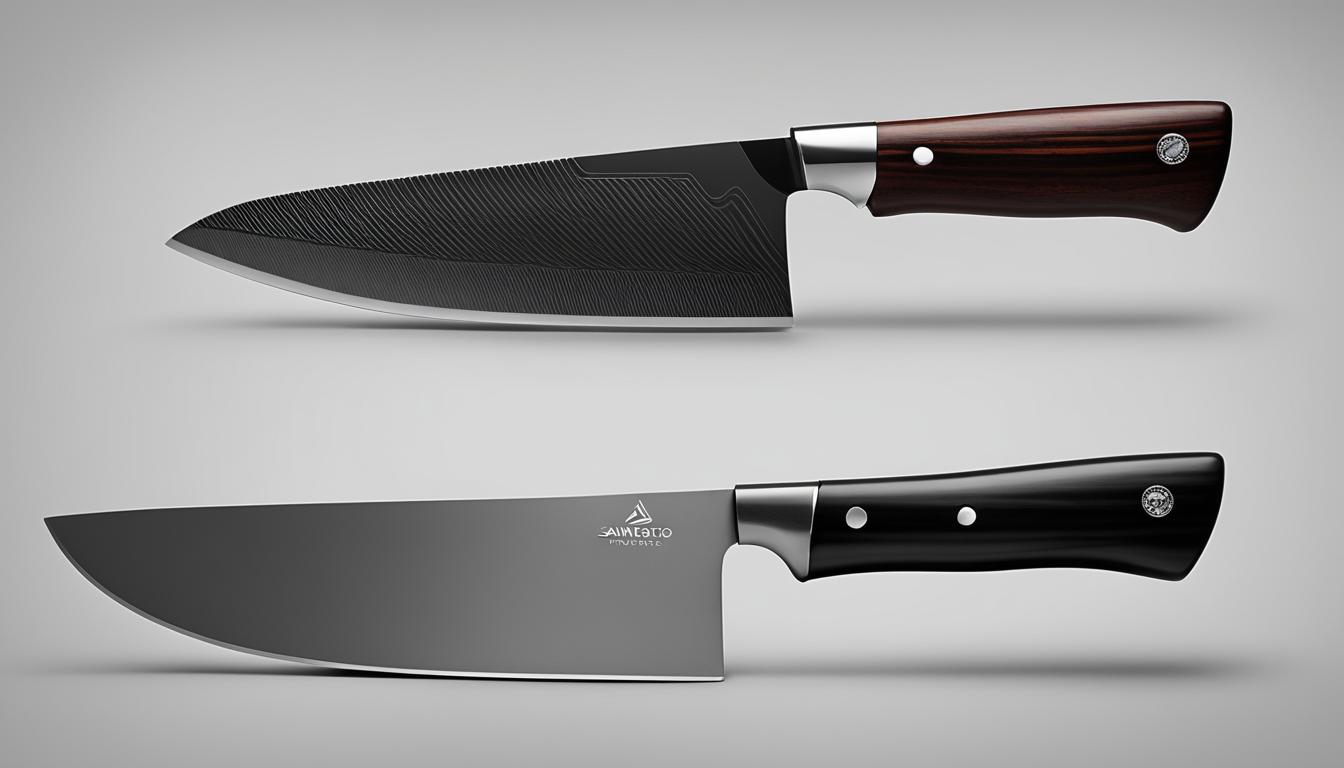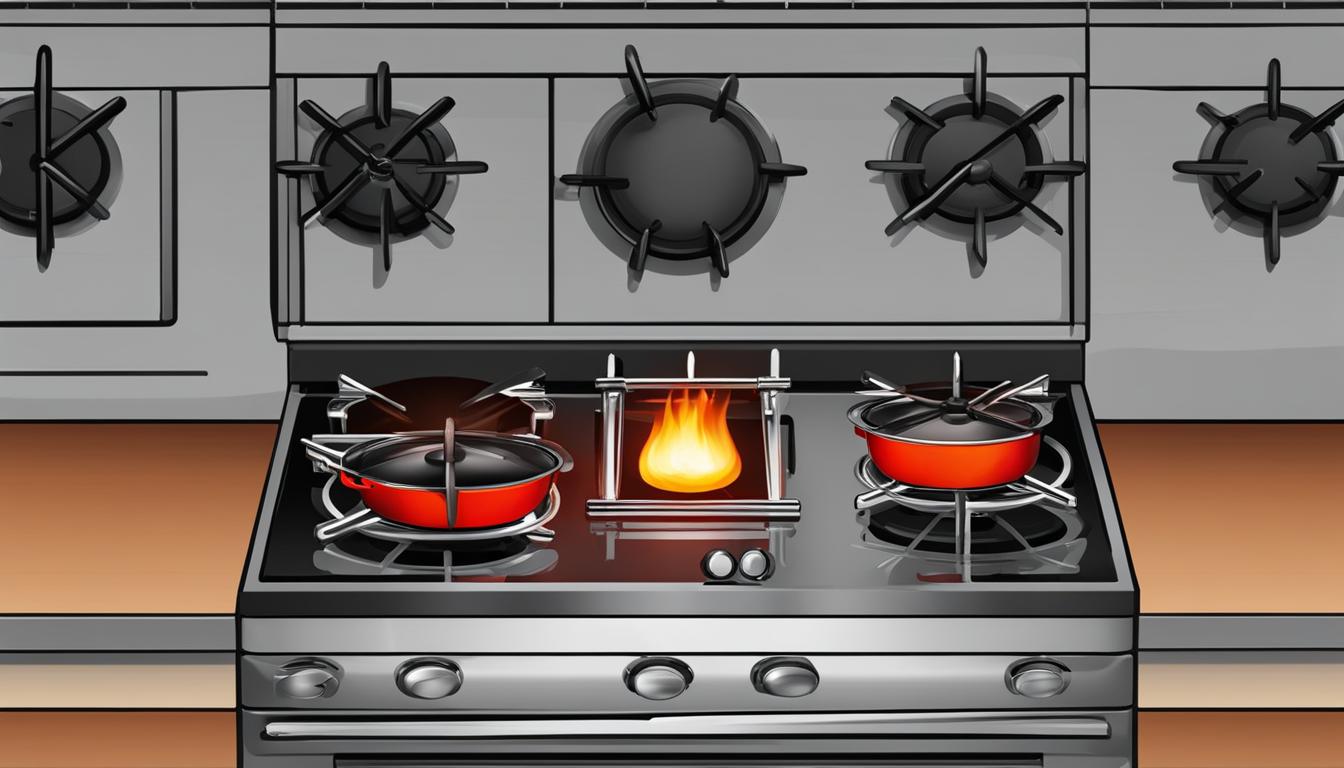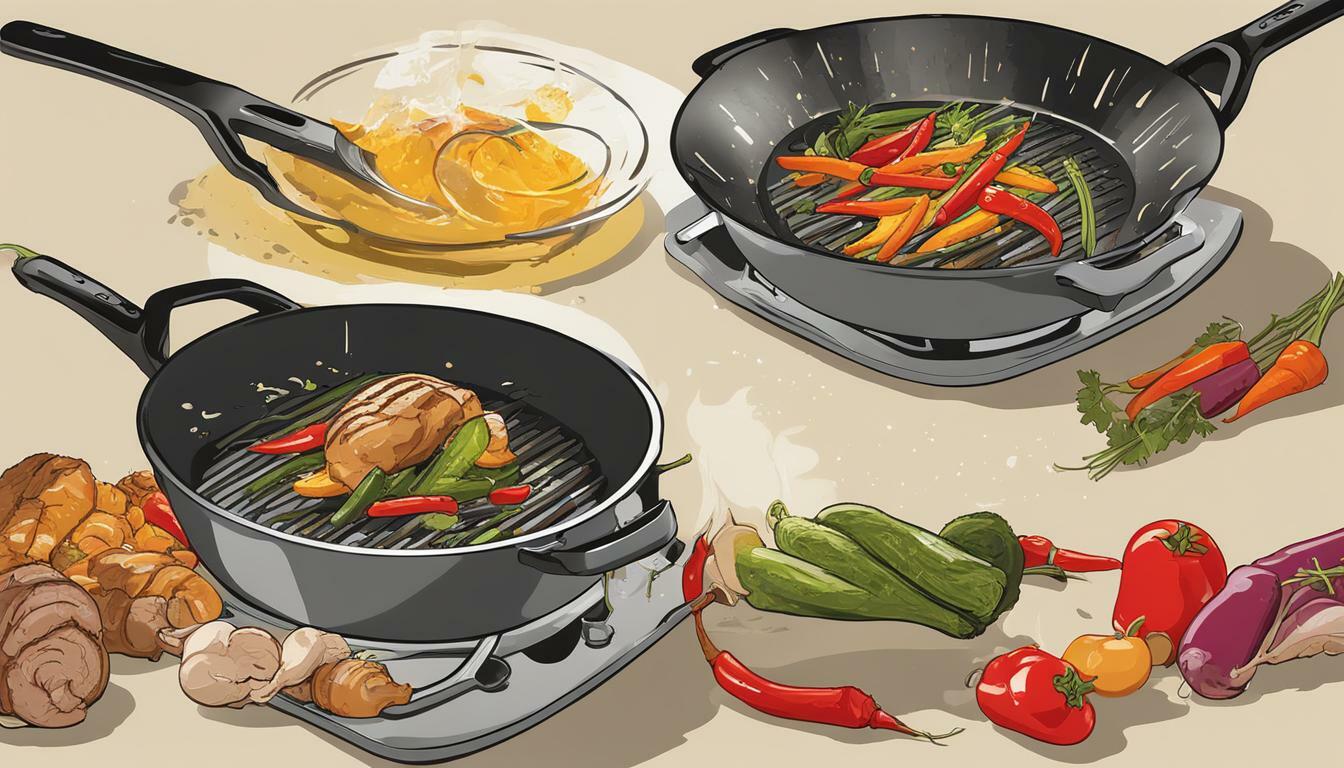When it comes to selecting the right knife for your kitchen, understanding the key differences between a chef’s knife and a Santoku knife is essential. While both knives are versatile and commonly used for chopping, slicing, dicing, and mincing, they have distinct characteristics that set them apart.
A Santoku knife originated in Japan and features a wide sheepsfoot blade with no tip. In contrast, a chef’s knife, which originated in Germany and France, has a broad blade that curves upwards to form a tip. These differences in origin and blade shape significantly impact the knives’ performance and functionality.
Another notable difference lies in the materials used. Santoku knives are typically made of thinner and harder steel, allowing for more refined slicing. On the other hand, chef’s knives are often heavier and have a bolster, providing added weight and stability during cutting tasks.
When it comes to cutting techniques, chef’s knives are known for their suitability for rocking motions, making them ideal for finely chopping herbs. Santoku knives, on the other hand, are best used with a push cut technique, offering precise control and allowing for clean, precise cuts.
Ultimately, the choice between a chef’s knife and a Santoku knife depends on personal preference and the specific tasks you frequently undertake in the kitchen. Understanding the unique features and uses of each knife will help you make an informed decision.
Key Takeaways:
- Both chef’s knives and Santoku knives are general-purpose knives used for chopping, slicing, dicing, and mincing.
- The key differences lie in their origin, blade shape, and materials used.
- Santoku knives are best for chopping, dicing, mincing, and creating fine slices, while chef’s knives are versatile and suitable for complex cuts, slicing cheese, and chopping or dicing fruits, vegetables, and nuts.
- Caring for both knives involves hand washing, drying, and appropriate sharpening techniques.
- Ultimately, the choice between the two depends on personal preference and the specific cutting tasks at hand.
Santoku Knife Features and Uses
A Santoku knife is a versatile kitchen tool that originated in Japan. It features a wide sheepsfoot blade with no tip, making it ideal for precise slicing and chopping. The characteristics of a Santoku knife set it apart from other knives, including its thin blade, lightweight design, and unique cutting technique.
The thin blade of a Santoku knife allows for more refined slicing compared to other knives. It is commonly made of harder steel, which provides excellent durability and edge retention. The absence of a tip in the blade design allows for smoother slicing motions and prevents accidental piercing of ingredients.
Santoku knives typically do not have a bolster, which is a thickened area between the blade and handle found in many other knife types. This absence of a bolster contributes to the knife’s lighter weight, making it easier to handle and maneuver. The blade of a Santoku knife is also shorter in length compared to a chef’s knife, making it suitable for a variety of slicing, dicing, and chopping tasks.
Santoku Knife Uses
- Cutting meat: The sharp and thin blade of a Santoku knife makes it perfect for slicing through various types of meat with precision.
- Slicing cheese: The wide blade and smooth cutting motion of a Santoku knife are well-suited for slicing cheese into thin, even slices.
- Chopping and dicing fruits, vegetables, and nuts: The Santoku knife’s versatile blade allows for efficient chopping and dicing of a wide range of ingredients.
- Mincing meat or herbs: The fine edge of a Santoku knife is excellent for mincing both meat and herbs to achieve the desired consistency.
- Scooping food off a cutting board: The wide blade of a Santoku knife allows for easy scooping and transferring of chopped ingredients from the cutting board to a bowl or pan.
- Creating fine slices: The thin blade and precise cutting technique of a Santoku knife enable the creation of fine slices for garnishes or delicate dishes.
Overall, a Santoku knife is a versatile and efficient kitchen tool that excels in various cutting tasks. Its unique features and design make it a favorite among professional chefs and home cooks alike.
| Characteristic | Santoku Knife | Chef’s Knife |
|---|---|---|
| Origin | Japan | Germany and France |
| Blade Shape | Wide sheepsfoot with no tip | Broad and curved upwards to form a tip |
| Blade Thickness | Thinner | Thicker |
| Blade Material | Harder Steel | Steel |
| Bolster | No | Yes |
| Weight | Lighter | Heavier |
| Common Uses | Chopping, slicing, dicing, mincing, scooping | Complex cuts, slicing cheese, chopping, dicing, disjointing |
Chef’s Knife Features and Uses
A chef’s knife is a versatile and essential tool in any kitchen. Known for its broad blade that curves upwards to form a tip, this knife offers unique characteristics that set it apart from other knives. Let’s explore the key features and uses of a chef’s knife.
Knife Characteristics
A chef’s knife is typically made of steel and has a thicker spine, providing added weight and stability. This weight allows for precise control and effortless cutting. The blade of a chef’s knife is usually serrated, which enhances its cutting performance and ensures clean, smooth slices. Additionally, chef’s knives have a bolster, a thick junction between the blade and the handle, which provides balance and prevents hand fatigue during prolonged use.
Knife Uses
The versatility of a chef’s knife makes it suitable for a wide range of cutting tasks. Its broad blade allows for efficient slicing, dicing, and chopping of fruits, vegetables, and nuts. Whether you’re preparing a salad, mincing herbs, or cubing meat, a chef’s knife can handle it all. Moreover, its sturdy construction and serrated edge make it perfect for slicing through tough-skinned produce, such as pineapples or melons. With a chef’s knife, you can also achieve uniform slices of cheese or disjoint poultry with ease.
Overall, a chef’s knife is a reliable and indispensable tool in the kitchen. Its exceptional cutting performance, balance, and versatility make it a favorite among both professional chefs and home cooks.
Caring for a Santoku Knife and Chef’s Knife
Proper care and maintenance are crucial for ensuring the longevity and performance of both Santoku knives and chef’s knives. By following these care guidelines, you can preserve the sharpness and functionality of your knives for years to come.
Cleaning and Drying
Both Santoku knives and chef’s knives should always be hand washed with mild soap and warm water. Avoid using harsh detergents or dishwashers, as they can cause damage to the blades and handles. After washing, thoroughly dry the knives with a clean cloth to prevent rust and corrosion.
Storage
When not in use, it is best to store your knives in a wooden knife block, magnetic strip, or knife sheath. These storage options protect the blades from coming into contact with other utensils, minimizing the risk of nicks and scratches. Avoid storing knives in drawers or leaving them exposed on countertops, as this can lead to accidents and damage.

Sharpening
Regular sharpening is essential for maintaining the sharpness of both Santoku knives and chef’s knives. While the frequency of sharpening depends on usage, it is generally recommended to sharpen the knives every few months or when you notice a decrease in their cutting performance. Santoku knives can be sharpened to a finer angle due to their single bevel, while chef’s knives are typically sharpened at a slightly wider angle. If you’re unsure about the sharpening process, it’s best to seek professional assistance or use a reliable knife sharpening tool.
Additional Tips
- Avoid using Santoku knives and chef’s knives on hard surfaces like glass or marble, as this can cause damage to the blades.
- Never use the knives to pry open cans, as this can lead to blade damage or breakage.
- Regularly inspect the handles for any signs of wear or loosening. If the handles become loose, have them repaired or replaced to ensure safe and comfortable use.
By incorporating these care practices into your routine, you can extend the lifespan of your Santoku knife and chef’s knife while enjoying their excellent cutting performance in your culinary endeavors.
Differences in Cutting Techniques
When it comes to cutting techniques, the shape of the blade plays a crucial role in determining the most effective approach. Santoku knives and chef’s knives have distinct cutting techniques that cater to different styles of cooking and ingredient preparation.
Santoku Cutting Technique
The Santoku knife, with its wide sheepsfoot blade and absence of a tip, is best utilized with a push cut technique. To employ this technique, grip the handle firmly and position your fingers close to the blade for optimal control. Begin by placing the knife at a diagonal angle on the ingredient, cutting from the back-top to the bottom-front. After completing the cut, lift the blade back to the starting position. This technique allows for precise and controlled slicing, making it ideal for tasks such as chopping, dicing, and mincing.
Chef Knife Cutting Technique
Chef’s knives, with their broad blades and curved tips, are well-suited for rocking motions during cutting. This versatile cutting technique is particularly useful for finely chopping herbs. To execute a rocking motion, place the knife’s heel on the cutting board and use a gentle back-and-forth motion, pivoting from the tip to the heel. The curved blade facilitates the rocking motion, allowing for efficient and consistent cuts. Chef’s knives are ideal for complex cuts, slicing cheese, and chopping or dicing a wide range of ingredients.
Both Santoku knives and chef’s knives can be used to cut the same ingredients, but the cutting techniques vary. The choice of knife and technique depends on personal preference, the desired outcome, and the specific cutting tasks at hand. By understanding the distinctive characteristics of each knife and their associated cutting techniques, chefs and home cooks can enhance their culinary skills and achieve optimal results in the kitchen.
Conclusion
Both chef’s knives and Santoku knives offer unique features and are designed for specific cutting tasks. Choosing between the two ultimately depends on personal preference and the type of culinary work at hand.
Santoku knives excel in tasks such as chopping, dicing, mincing, creating fine slices, and even scooping food off a cutting board. With their wide sheepsfoot blade and thinner steel, they provide precise slicing and refined cuts.
On the other hand, chef’s knives are versatile tools that can handle complex cuts, slicing cheese, and tackling a variety of fruits, vegetables, and nuts. The broad blade, curved tip, and heavier weight make them suitable for a range of kitchen tasks.
To ensure the longevity of both knives, proper care is essential. Hand washing and thorough drying should be carried out to prevent rusting and damage. Furthermore, each knife requires suitable sharpening techniques, with Santoku knives benefiting from their single bevel and easier sharpening process.
FAQ
What are the key differences between a chef’s knife and a Santoku knife?
The key differences lie in their origin and blade shape. A Santoku knife originated in Japan and has a wide sheepsfoot blade with no tip, while a chef’s knife originated in Germany and France and has a broad blade that curves upwards to form a tip.
What are Santoku knives best used for?
Santoku knives are best used for chopping, dicing, and mincing. They are also ideal for creating fine slices and scooping food off a cutting board.
What are chef’s knives commonly used for?
Chef’s knives are commonly used for complex or versatile cutting tasks, slicing cheese, and chopping or dicing fruits, vegetables, and nuts.
What is the difference in blade thickness between Santoku knives and chef’s knives?
Santoku knives have a thinner blade compared to chef’s knives, which allows for more refined slicing.
How should Santoku knives and chef’s knives be cared for?
Both knives should be hand washed and dried to prevent rusting or damage. It is best to avoid washing them in a dishwasher or scrubbing them with scourers. When not in use, they should be stored in a wooden box or block.
What are the differences in cutting techniques between Santoku knives and chef’s knives?
The shape of the blade affects the cutting techniques used. Chef’s knives are suitable for rocking motions, while Santoku knives are best used with a push cut technique, where you grip the blade close to the handle for precise control.
Can Santoku knives and chef’s knives be used to cut the same ingredients?
Yes, both knives can be used to cut the same ingredients. However, the cutting techniques may vary depending on the knife being used.
How should Santoku knives and chef’s knives be sharpened?
Santoku knives can be sharpened to a finer angle due to their single bevel, while chef’s knives are sharpened at a slightly wider angle. Santoku knives are generally easier to sharpen as they don’t have a bolster.
Which knife should I choose, a Santoku knife or a chef’s knife?
The choice between the two depends on personal preference and the specific cutting tasks at hand. Santoku knives are best for chopping, dicing, mincing, creating fine slices, and scooping food off a cutting board. Chef’s knives are versatile and suitable for complex cuts, slicing cheese, and chopping or dicing fruits, vegetables, and nuts.
 Skip to main content
Skip to main content


